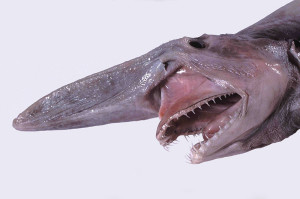Goblin Shark Territory:
No Map Yet!
Goblin Shark Basic Facts:
No Facts Yet!
Goblin Shark Photos:
Goblin Shark, nick named the prehistoric shark, commonly known as Mitsukurina owstoni by the Japanese is an indigenous species of the shark. It gets its name, because of its goblin like appearance. Unlike other species of the shark, Goblin Shark is found 1200m (4800ft) deep in the sea. From this we are able to conclude that the Goblin Shark does not depend on the normal features other sharks use in search of their prey. Being 1200m deep in the sea means that there is a little sun penetrating the water to reach the sea surface. Thus, the Goblin Shark has some unique features that help it catch its prey. They use color or fantastic displays to get to their prey. They use electro-sensitive body organs to help them feel the presence of prey in their path.
There are several research cases that have been done by scientists from all over the world. So far there are only 45 documented files bearing the research on the Goblin Shark. Scientists have found that Goblin Shark would have probably been living since the prehistoric times. They term it as one of the oldest living creatures on earth.
They are weird in appearance with a soft, flabby and a blade like body. They have very long noses and their jaws are extremely sharp with fang like teeth. The surprising feature about the snout is that the snout tends to get smaller with increase in age. Averagely, an old Goblin Shark grows to a length of 3.8m (15.2ft). However, there was a capture of an extra-large Goblin Shark which was estimated to be measuring 5.4 to 6.2 m (18 to 20 ft). For an average sized Goblin Shark, is weight is estimated to be 210 kg (460lb).
Goblin Sharks are harmless to humans. This is due to the fact that their habitat is normally so deep in the sea. Goblin Shark likes feeding on crabs, squid and deep sea fish like dragon fishes and the rattails.
A Goblin Shark was captured and kept at Tokai University where it only survived a week. The good thing about the shark is that it also has an economical value. Its meat is salted and sold as food while its jaws are normally sold for steep prices by collectors. There was a time when the Japanese used it for liver oil and production of fertilizer.

